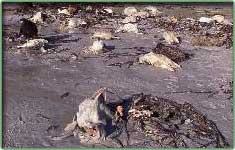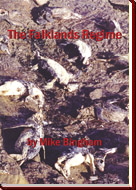 |
 |
|
|
|
|
|
|
|
|
|
|
|
In 1982 the Falklands had six million
penguins, now there are less than one million. At least 100,000 penguins have died from starvation during May 2002 in the Falkland Islands. Penguin colonies throughout the Falklands are littered with dead penguins, some fresh, some partially decayed with bones protruding. All have died within the last few weeks, and all have died during their annual moult. Their condition and weight show that they all died as a result of starvation. Rockhopper and Gentoo penguins are the worst affected, with Magellanic penguins and cormorants also dying. The worst affected areas are along the north of the islands, where 50% of the Rockhopper penguin population and 10% of the Gentoo penguin population has died. Some birds barely alive, still undergoing their moult in June, are too weak to walk. Vultures and caracaras follow them around waiting for them to die. The Rockhoppers average weight is under 2kg and Gentoos just 4kg. But why are so many penguins dying during the course of a few weeks? When penguins change their feathers, they loose their insulation, making it impossible to enter the icy cold ocean to feed for about three weeks. Penguins fatten themselves up during February and March ready for the moult, but if food is too scarce during this period, they are in trouble. Without enough fat reserves to survive three weeks without food they are doomed, like a car setting out on a 100 mile journey without enough petrol. When the fuel runs out, the motor stops, and the penguin dies. The same thing occurred in 1986, when over a million Rockhopper penguins starved to death in exactly the same manner as has occurred this year. Mass starvation of adults is not the only evidence of food shortage around the Falklands. Penguin chicks also starve to death by the thousand every year in the Falklands. A joint research project between the Environmental Research Unit and the Chilean government, funded by the British government, shows that penguin chicks in Chile and Argentina do not starve in large numbers like they do in the Falklands. On the contrary, there is evidence that some penguins are moving from the Falklands to South America where food is more plentiful. The nearest Rockhopper penguin colony to the Falklands is on Staten Island, Argentina. Populations have increased rapidly on Staten Island, whilst populations in the Falklands have been crashing. The population increase on Staten Island has been so rapid that it cannot be explained by breeding success alone, suggesting that Rockhopper penguins have been moving there from somewhere else. The only likely source was the Falkland Islands. A few years ago Gentoo penguins did not breed anywhere in South America, but during the 1990s, when Gentoo penguins were declining in the Falklands, two small colonies appeared in Argentina. With no other Gentoos in South America, the only nearby source was the Falkland Islands. Magdalena Island in Chile is the nearest colony of Magellanic penguin burrows to the Falklands. Many years ago commercial fishing was allowed around the island, and the penguins declined. Then the Chilean government declared Magdalena Island a nature reserve, and established a no-fishing zone around the island, since when penguin populations have flourished. Unfortunately the Falkland Islands Government have still not established any protective measures in Falklands waters, and the differences are striking. Magellanic penguins in Chile, where a no-fishing zone has been established, can find food for their chicks in just 14 hours. By comparison, Magellanic penguins in the Falklands, where commercial fishing still occurs close to penguin colonies, need an average of over 34 hours - more than twice as long to find the same quantity of food. With chicks in the Falklands receiving less than half the amount of food, it is not surprising that most of them starve. In Chile an average of 1.4 chicks per nest survive, whilst in the Falklands it is less than half that, this year recording an appallingly low 0.5 chicks per nest. The reason for such low reproductive success is that most chicks in the Falklands die from starvation every year. In 1982, British troops sent to the Falklands were told they were liberating an island of 2,000 people and 6 million penguins, a figure supported by the ICBP (Status and Conservation of Seabirds at the Falkland Islands) in 1984. These 6 million penguins have crashed to less than 1 million over the last 20 years, due to insufficient fish and squid around the Falklands. This coincides with the establishment of a squid and fishing industry around the Falklands. Falkland Islands Sealions and Elephant seals which also rely on fish and squid have also crashed in number over recent years. In September 2000, the Spheniscus Penguin Conservation Group, and the International Penguin Conservation Work Group, called for a 30 mile exclusion zone around penguin colonies world-wide. So far the Falkland Islands Government have not implemented this protection, and penguins continue to starve. If the Falkland Islands Government were to impose a no-fishing zone around penguin colonies, then it would help penguins to recover, as occurred when Chile introduced such measures. Such a no-fishing zone would reduce the available fishing grounds in the Falklands by less than 3% - hardly a dramatic financial loss to a government with an income of $30,000 per man, woman and child. If a relatively poor country such as Chile can protect its penguins in such a manner, then why can't the Falklands? Click here to see our letter to the Falkland Islands Government asking for the introduction of no-fishing zones around penguin breeding sites |
|
|||||||||||||||||||||||||||||




